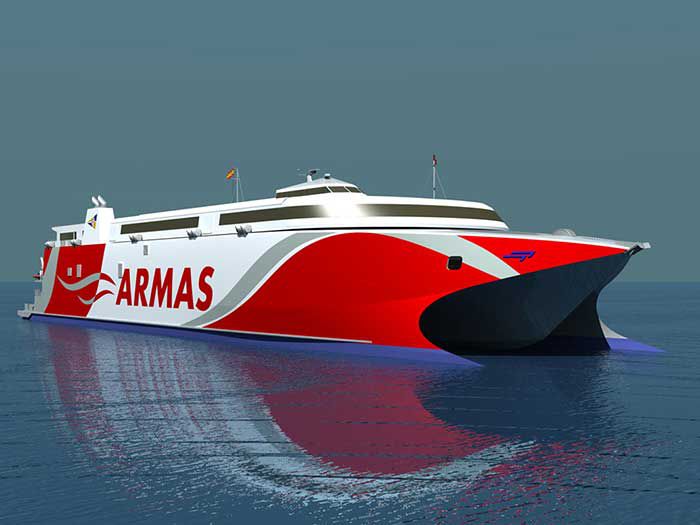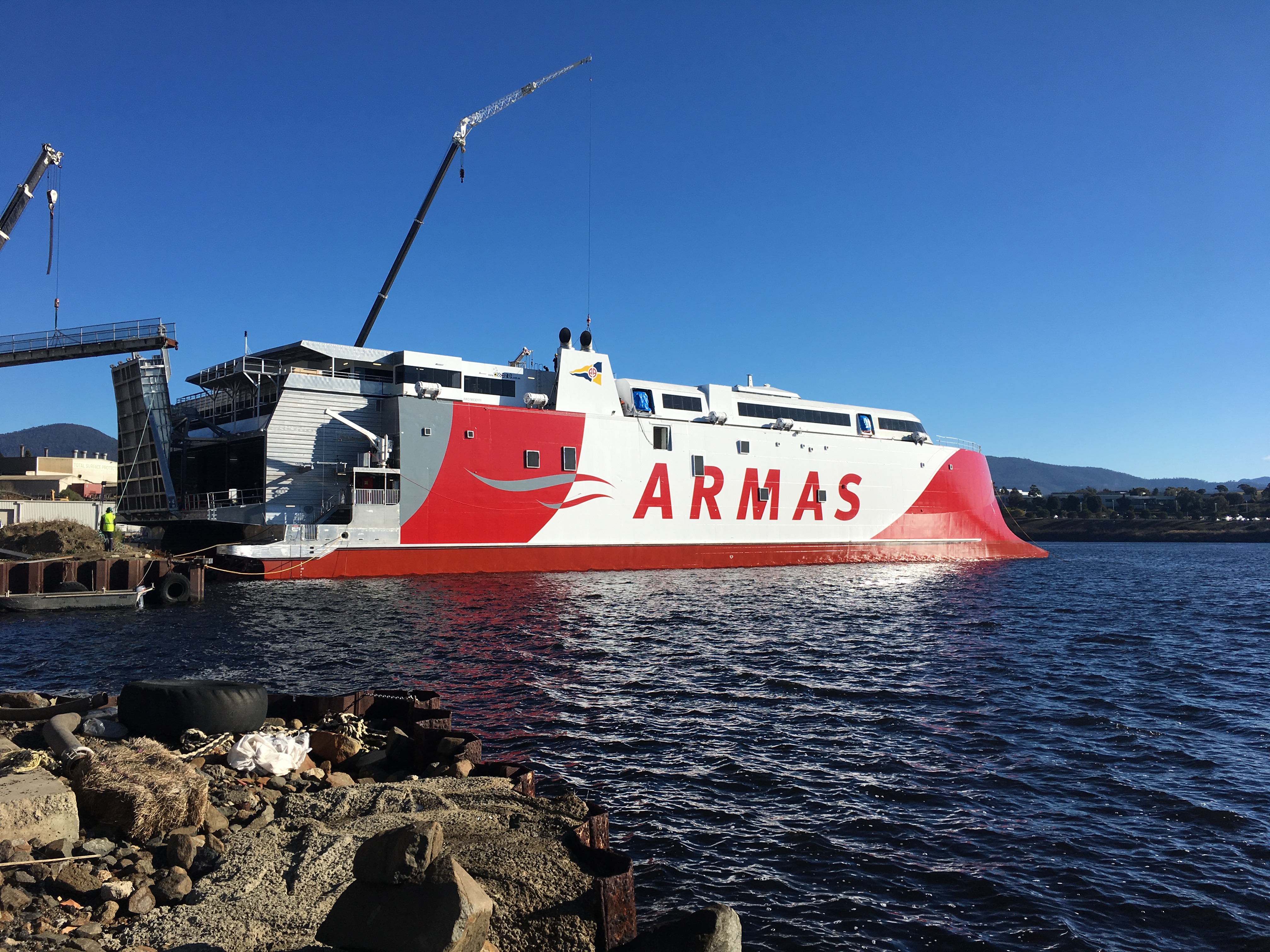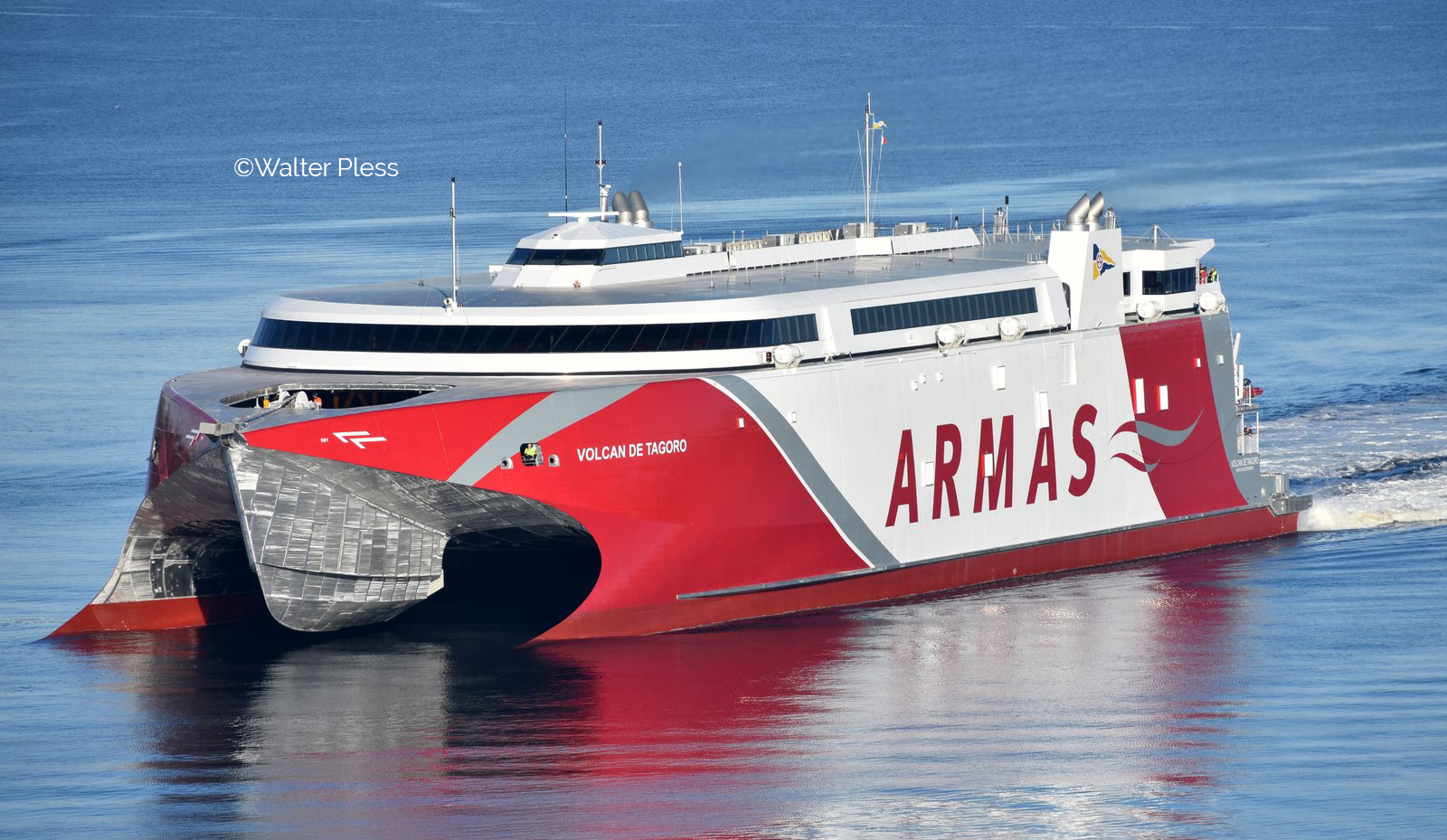Spanish operator orders 109 m Incat wavepiercer
MAY 9, 2017 — Spain's Naviera Armas has awarded Australian shipbuilder Incat Tasmania a significant contract for the design and construction of a large new vehicle-passenger ferry.
The contract price is EUR 74 million (about US$81million) and construction of the vessel will commence in June 2017.
The Naviera Armas newbuild will be the second vessel in Incat's new generation 109 m high speed wave piercing catamaran range and is scheduled for delivery in early 2019.
Developed based on extensive in-service experience with Incat's 112 m series, the concept was redesigned from the keel up by Incat's in-house naval architects and engineers at Revolution Design Pty Ltd. The resulting 109 m cat offers similar passenger and vehicle capacity to the 112 m design, but delivers substantial performance improvements, including improved speed, lower fuel consumption and enhanced directional stability.
This latest refinement of Incat's well proven wave piercing hullform was first introduced in Molslinjen' 109 m wave piercing catamaran Express 3, delivered in April.
During sea trials Expresss 3 achieved an impressive speed of 43 knots at 600 tonnes deadweight.
Naviera Armas is actively investing in high speed craft. This new vessel will be the third Incat craft to join the Naviera Armas fleet in as many years, following Volcán de Tirajana (Incat Hull 062, 98 metre) purchased in 2015 and Volcán de Teno (Incat Hull 056, 96 metre) acquired last year.
Robert Clifford, Incat's Chairman, commented: "Our vessels are well proven around the world in rough water conditions. In wanting to offer their passengers the very best in reliability and comfort, Naviera Armas sought the qualities of the wave piercing catamaran and compared even with their earlier Incat vessels this new generation craft for Armas will be a real step up in terms of passenger comfort and economies of scale."
The first two Incat vessels in the Naviera Armas fleet were purchased after completing service elsewhere in Southern Europe but. as Armas CEO Antonio Armas explains, significant global demand for fast ferries is translating to orders for newbuild tonnage.
"It is very hard to find quality second hand high speed ferries in the market, nevertheless given the performance of the two Incat-built vessels already purchased we are confident the wait for the newbuild 109 m will be well worth it. This new Incat 109 metre will provide a service speed of 35 knots (65km/h) and accommodate 1,200 persons including 155 persons in business class. It will also be the first high speed ferry in southern Europe to feature a dual vehicle deck allowing cars and freight to be transported separately. The main deck has capacity for 595 truck lane m with a 4.6 mclear height and the upper deck will accommodate 215 cars." Mr Armas says.
Incat is also building a state-of-the-art 110 m fast ferry for Mediterranean company Virtu Ferries for service between Malta and Sicily. That new ship (Incat Hull 089) is scheduled for delivery at the end of 2018.
Incat currently has a 550-strong workforce at its Hobart shipyard and the yard is geared for delivering up to two large HSC per year.
Kilde: MarineLog

Illustrasjon: Incat
MAY 9, 2017 — Spain's Naviera Armas has awarded Australian shipbuilder Incat Tasmania a significant contract for the design and construction of a large new vehicle-passenger ferry.
The contract price is EUR 74 million (about US$81million) and construction of the vessel will commence in June 2017.
The Naviera Armas newbuild will be the second vessel in Incat's new generation 109 m high speed wave piercing catamaran range and is scheduled for delivery in early 2019.
Developed based on extensive in-service experience with Incat's 112 m series, the concept was redesigned from the keel up by Incat's in-house naval architects and engineers at Revolution Design Pty Ltd. The resulting 109 m cat offers similar passenger and vehicle capacity to the 112 m design, but delivers substantial performance improvements, including improved speed, lower fuel consumption and enhanced directional stability.
This latest refinement of Incat's well proven wave piercing hullform was first introduced in Molslinjen' 109 m wave piercing catamaran Express 3, delivered in April.
During sea trials Expresss 3 achieved an impressive speed of 43 knots at 600 tonnes deadweight.
Naviera Armas is actively investing in high speed craft. This new vessel will be the third Incat craft to join the Naviera Armas fleet in as many years, following Volcán de Tirajana (Incat Hull 062, 98 metre) purchased in 2015 and Volcán de Teno (Incat Hull 056, 96 metre) acquired last year.
Robert Clifford, Incat's Chairman, commented: "Our vessels are well proven around the world in rough water conditions. In wanting to offer their passengers the very best in reliability and comfort, Naviera Armas sought the qualities of the wave piercing catamaran and compared even with their earlier Incat vessels this new generation craft for Armas will be a real step up in terms of passenger comfort and economies of scale."
The first two Incat vessels in the Naviera Armas fleet were purchased after completing service elsewhere in Southern Europe but. as Armas CEO Antonio Armas explains, significant global demand for fast ferries is translating to orders for newbuild tonnage.
"It is very hard to find quality second hand high speed ferries in the market, nevertheless given the performance of the two Incat-built vessels already purchased we are confident the wait for the newbuild 109 m will be well worth it. This new Incat 109 metre will provide a service speed of 35 knots (65km/h) and accommodate 1,200 persons including 155 persons in business class. It will also be the first high speed ferry in southern Europe to feature a dual vehicle deck allowing cars and freight to be transported separately. The main deck has capacity for 595 truck lane m with a 4.6 mclear height and the upper deck will accommodate 215 cars." Mr Armas says.
Incat is also building a state-of-the-art 110 m fast ferry for Mediterranean company Virtu Ferries for service between Malta and Sicily. That new ship (Incat Hull 089) is scheduled for delivery at the end of 2018.
Incat currently has a 550-strong workforce at its Hobart shipyard and the yard is geared for delivering up to two large HSC per year.
Kilde: MarineLog

Illustrasjon: Incat


